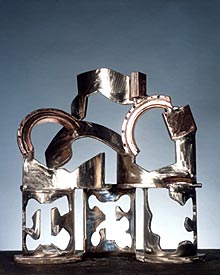Sculpting Copper: Movement through Welding
 Conversion, copper and bronze
Conversion, copper and bronzePhotograph courtesy of John Sanders
"It's considered old fashioned to be a welder," says John Sanders, sculptor from New York. It's also expensive and time consuming. He started off working with stone after receiving his MFA in Sculpture from Berkeley in California, and then migrated into steel, bronze and copper.
Sanders sources his copper by another old-fashioned method---He scrounges around junkyards for it.
"I've hit every scrap yard with 150 miles of New York," he says. "It's like gambling. When I find some copper it's so exciting."
One time he found three-inch thick copper furnaces once owned by IBM that he snapped up quickly. He'll take scrap, preferably ½ inch or 3/8, and cut shapes out of the plate, then bend it to get the forms he desires.
"The fantastic thing about copper is that it lends itself to cold bending in a vice just like blacksmithing and you can move it. If I get one inch thick I can get rigidity from the copper, but I have to forge it."
His penchant for movement is clearly evident in his sculptures. Though he also sculpts with steel, even wood, he says "copper has the ultimate advantage of movement in metal, unlike the difficulty of stainless steel." His preference is to use bronze and copper together as complementary metals.
"Bronze, which is 90% copper, welds together in a beautiful way. When you get good at it, it's like working in wax. It moves so quickly and liquefies. But, the minute you stop, it freezes the way steel does."
This flexibility allows him to create virtually any shape he wants. His sculptures, abstract and replete with negative space, are always in the process of morphing into another shape as they bend and flow. And, if he's dissatisfied with the outcome, he can forge the work into something else.
"Copper flexes and has this timelessness," he adds. "It's beautiful."
Sanders carves his copper with a plasma arc and attains the colors he wants with the different heats he uses when welding. Like most people, he has a fascination with the way copper ages, admiring the variety of patinas and verdigris that copper can assume.
"People are deeply attracted to copper because of the color," he notes. But Sanders goes another step. "I lacquer my copper pieces so they age from the inside out. Copper is permanent to the weather…it tarnishes but won't rust."
Sanders works out of an old dairy farm 40 feet wide and 300 feet long, deep in the heart of the Catskills Mountains where he draws inspiration from the natural environment around him. Directly outside his studio doors are expansive views of the surrounding hills. Just like in nature, there are virtually no hard right angles in his work.
"I'm confronted with magnificent views and it affects me," he says. "I'm very influenced by my environment. My pieces are organic, almost too organic, so I throw these solid pieces into the sculpture. Most of my ideas come from my mistakes."
His work is large and heavy, precluding too many shows, though he has shown extensively in New York as well as shows in Germany, Berkeley, Massachusetts and Washington D.C. A 2000 commission in China called Average Hectic Day weighed in 55,000 pounds, looming at 18 feet high. Most pieces are smaller, but still there is significant cost to move them.
His preference is for guests to visit him at his studio. He is currently negotiating with Stone Ridge, a sculpture garden and gallery, for a show in the summer of 2008 in New York.
"When you work with copper it's like a love affair," he says fondly. "I adore it and will do it forever."
Also in this Issue:
- The Revived Art of Brass and Bronze Marine Hardware
- Apprentice and Alchemist: Tanya Garvis
- Sculpting Copper: Movement through Welding
- Rediscovering the Geddy Foundry's Colonial Roots
- The NSS Presents 75th Annual Awards Exhibition
